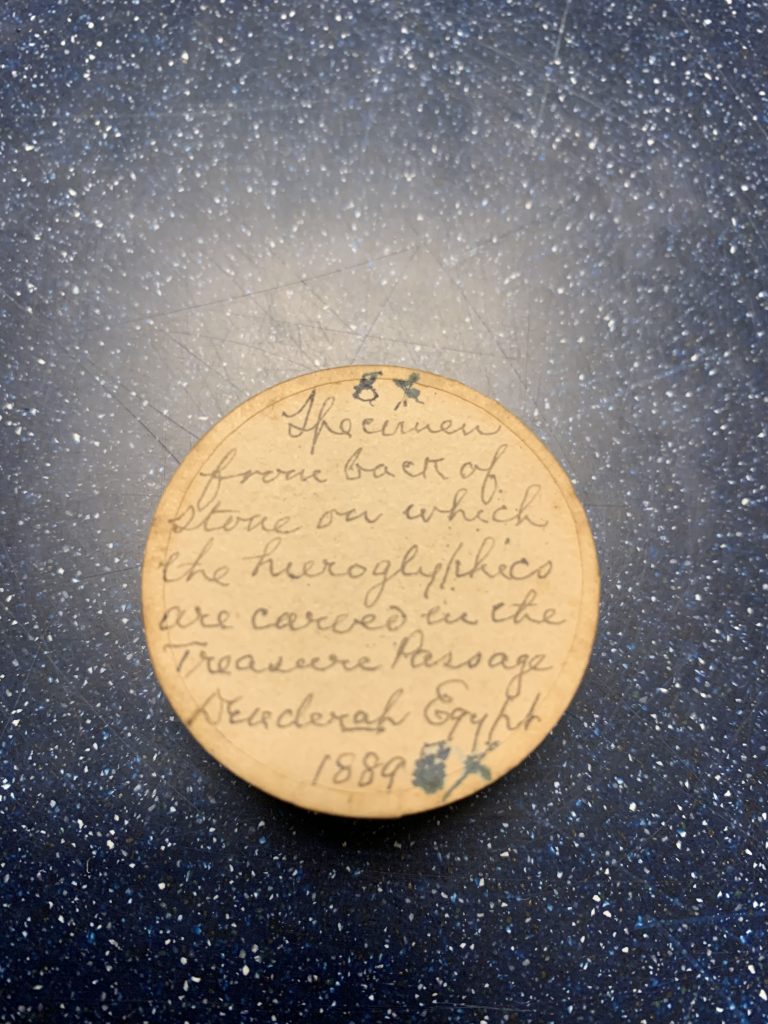- Date Acquired: 1889
- Place Acquired: Dendera Temple Complex, Dendera, Egypt
- Coordinates: 26° 08’ 18.00” N 32° 40’ 7.79” E
- BM# 1948.64.104
In 1889, General Reeve set out on an expedition across the Mediterranean visiting the Aegean Islands, Syria, and Egypt along with his wife and ten other companions. Along his route across Egypt, he visited the Dendera Temple Complex located approximately 40 miles north of Luxor, Egypt. Upon reaching the temple complex, Reeve immediately noted on the brick wall which formed a circle around the perimeter of the temple complex. At the time of Reeve’s visit, there was evidence of early Christians defacing almost all of the reliefs except in a few secret passageways which he notes in his book, How We Went and What We Saw: A Flying Trip Through Egypt, Syria, and the Aegean Islands. Reeve comments on the exceptional state of preservation of the temple (aside from the defacement) and its significance as the only temple in Egypt dedicated solely to Hathor.
The Dendera Temple Complex consists of several structures which were built across the span of the Middle Kingdom, the Ptolemaic Era, and the Roman period. There is a basilica, two birth houses, a sacred lake, and a number of temples and shrines. The temple complex was the center of the cult of Hathor, the Temple of Hathor being the most prominent building in the complex and built during the Ptolemaic period. The temple also housed the Zodiac of Dendera, now in the Louvre Museum, which depicted a map of the sky. Hathor has several titles including “Lady of the Stars” and “Mistress of Heaven” which relate to the Dendera Zodiac, but she later assimilated attributes from other goddesses such as Isis and Bastet and thus became “The Great One of Many Names”. The standing structures in the temple complex mostly date from the Ptolemaic period (332-30 BCE) and later, but evidence shows the first building was likely built around 2250 BCE. Cartouches of almost all the Roman emperors between Octavian (30 BCE) and Marcus Aurelius (161-80 BCE) were found on the wall of the Temple of Hathor. Other engravings on the wall of the Temple record the series of sanctuaries dedicated to Hathor which preceded the temple. This temple complex was one of the last Pharaonic monuments built in Egypt.
During the Victorian Era, many Middle Eastern countries came under colonial rule of western nations. Orientalism, the western study of the East, spread exaggerated images of Middle Eastern life. Western scholarship portrayed the Middle East and its inhabitants as the “other”, to be studied and marveled at because of its “backward” and “primitive” practices. The west exoticized the east and the Muslim religion particularly during the mid to late 1800’s when western nations began to establish colonies and protectorates throughout the Middle Eastern and North African region. With the completion of the Suez Canal in 1869, Egypt became significantly more accessible to western powers. In 1875, Egypt went bankrupt and European bankers took financial control over Egypt which eventually resulted in the British conquest of Egypt in 1882. Reeve’s expedition is an example of how members of western colonial societies took advantage of British control of Egypt and other Middle Eastern and North African countries.

Stehn, Rüdiger. Ägypten 1999 (511) Tempel von Dendera. 1999. Flickr.com. https://www.flickr.com/photos/rstehn/31181431006/in/photolist-PvoZ6q-PiruJB-NdYYzf-PGJcZy-NoGFAr-NCWf8k-PrB7hi-P4xJAW-NB111B-Ptw7oe-PT8f27-PpmnC7-M6Hs3q-NqqkKV-NiZebu-dMnDe6-dMnATX-dPonZQ-dMnAHZ-dPhKwB-dP4mn3-dMnDhg-dMnBW8-dMnBee-dMnB1X-P9FwD4-P3QwrN-dPhKDP-dP4miu-dMta1o-dPonEN-28jLJiT-dPonS1-dPonMq-dPonAY-dPhKfk-dPhK6H-PDueBY-dPhJZP-NGYXZ8-dPon8J-dMnBDP-dMtcSq-dMnANF-28jLEW2-GYpXCd-QZMYjY-dPhK3z-dPonr9-dMtaX1

Hathoric Columns. 2016. Archaeology Archive Project. Flickr.com. https://www.flickr.com/photos/archaeology-archive/27135370416/in/photolist-Gteh1y-GtehqG-GtjSfK-HkPmzs-Gtnnqe-HoK6LD-HkRNFb-HfkYB9-HhGA6T-HhK1X2-HhGMdx-HoKbbF-HoMkCT-HoMnhz-GtnugD-HkRSf5-HkPx3m-HoMeQa-HkPvJu-HkPxzJ-HkPguC-HfkYdy-HoKeHa-Gtc6B1-HfkTqN-GtcakJ-HhGJXa-Gtc6ph-Gtca53-HhGDMF-GYuKmN-HoKfzR-Gtk2FP-GtjUXP-HhGNDD-GtbYKA-HkPuhG-HfkVUL-GtjMxi-Gtc2SY-HfkRSh-HoKhPv-HoKgYc-GtjN9Z-HoKcZF-HkPhEJ-GYuVXN-HkPjWh-xEL5RL-xH5JKn/
For Further Reading:
- “Dendera Temple Complex.” Rosicrucian Egyptian Museum. https://egyptianmuseum.org/explore/middle-kingdom-monuments-dendera-temple-complex
- Reeve, Charles McCormick. 1891. How We Went and What We Saw: A Flying Trip Through Egypt, Syria, and the Aegean Islands (version digitized by Google). New York, NY: The Knickerbocker Press. https://play.google.com/books/reader?id=XAZBAAAAYAAJ]&hl=en&pg=GBS.PP1
- Cleary, Vern. “The Suez Canal and the British Conquest of Egypt.” Modern World History. http://webs.bcp.org/sites/vcleary/modernworldhistorytextbook/imperialism/section_6/suezcanal.html

